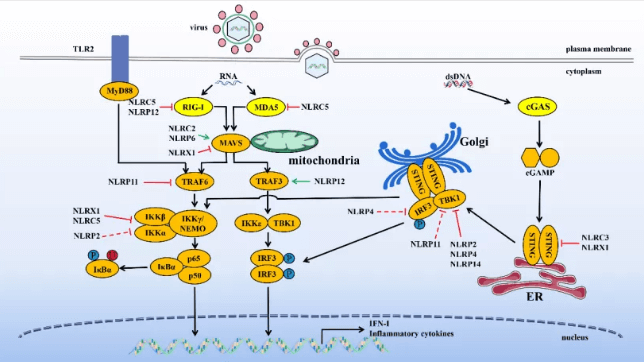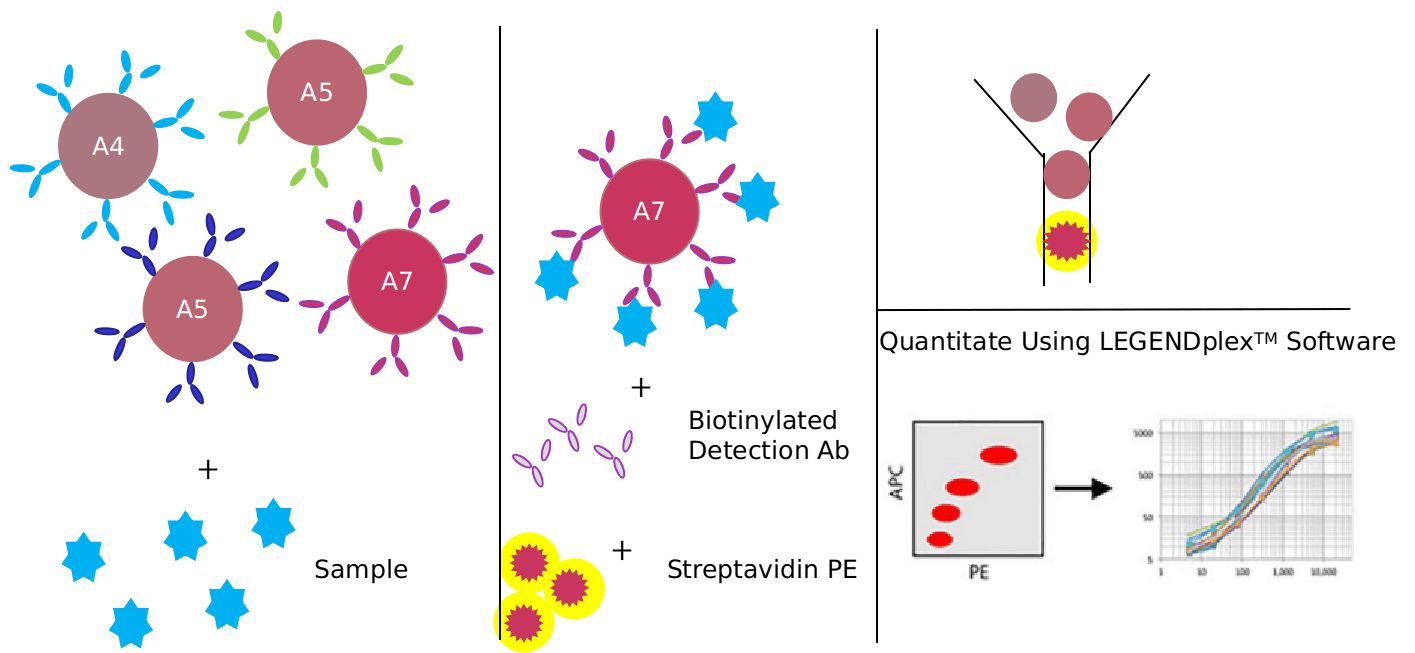Introduction to NOD-like Receptor signaling pathway
Based on Luminex technology platform, Creative Proteomics provides analysis services for key targets of NOD-like receptor signaling pathway.
NOD-like receptors are a type of pattern recognition receptors for the host. They contain more than 20 members in mammals. They can recognize the pathogen-related molecular patterns of viruses and play a key role in recognizing intracellular ligands.
NOD-like receptors mainly include NOD1 and NOD2, both of which are composed of 3 domains: the domain at the carboxyl terminal end is rich in leucine-rich repeats (LRR), which is mainly used for ligand recognition; The nucleotide-binding domain (NBD) in the middle of the molecule mainly plays a role in self-oligomerization dependent on adenosine triphosphate (ATP); the variable effector-binding domain (effector-binding domain) located at the amino terminal , EBD), which mediates the interaction between proteins and transmits signals downstream. Both NOD1 and NOD2 are caspase recruitment domains (CARD). The difference is that NOD1 contains one CARD, and NOD2 contains 2 CARDs.

As part of the innate immune response, NOD-like receptors have been the first to study the signal transduction pathway of bacterial invasion since their discovery. As a part of PRR, NOD-like receptors play a very important role in the innate immune response. They are not only expressed in innate immune cells, but also expressed in tumor cells. NOD-like receptors participate in anti-bacterial immune responses mainly through mediating NF-κB pathway, MAPK pathway and autophagy pathway. NOD2 receptors also mediate MAVS-IRF3/7-I type interferon signaling pathway to participate in antiviral immune response. In addition, , NOD-like receptors also have unique connection pathways with adaptive immune responses. NOD-like receptors also play a role in the occurrence and development of tumors, but in different tumors, NOD-like receptors play different roles. There are promoting and inhibiting.
Our detectable targets:
| MyD88 | RIG-1 | MDA5 | cGAS | MAVS | TRAF3 |
| TRAF6 | IKK-α | NEMO | IkBa | p58 | p65 |
| TBK1 | IKK-β | IRF3 | IKK-c | STLNG | NLRC3 |
| NLRX1 | IFN-1 | NFκB | RIG-1 |
Technology platform
We provide Luminex technology for NOD-like receptor signaling pathway analysis.
Luminex technology is a multifunctional liquid phase analysis platform developed on the basis of colored microspheres, laser technology, applied fluidics and high-speed digital signal processing technology. The core is to encode polypropylene microspheres or magnetic microspheres with fluorescent dyes. By adjusting the different ratios of the two fluorescent dyes, up to 100 microspheres with different fluorescence spectra can be obtained. Each kind of microspheres is covalently cross-linked. Capture antibodies against specific antigens.
NOD-like receptors are a type of pattern recognition receptor for the host. They contain more than 20 members in mammals. They can recognize the pathogen-related molecular patterns of viruses and play a key role in recognizing intracellular ligands.
In addition to Luminex Multiplex Assay, Enzyme-linked immunosorbent assay (ELISA), Flow cytometry (FACS analysis) technology can also be provided to meet other customer needs.
Advantages of NOD-like receptor signaling pathway detection:
- Versatility: VEGF signaling pathway technology can be applied to a variety of biological tests, including immune analysis, genotyping, gene expression, enzyme analysis, etc. It can detect both protein and nucleic acid. In addition to clinical use, it can also be used in scientific research, CDC, blood stations, agricultural, biological and pharmaceutical professional laboratories.
- Good repeatability: similar homogeneous reaction mode, each indicator has 1000-5000 reaction units, and the median value of 100 analysis is taken. High accuracy: the detection range is 35-6 orders of magnitude, which is very strong with ELISA and mass spectrometry.

Application of our service:
- To study the effect of each virus on NOD-like receptor signaling pathway
- To study the regulation mechanism of NOD-like receptor signal pathway in disease
- To study the effects of drugs or therapies on NOD-like receptor signaling pathways
Creative Proteomics has developed a signal pathway target detection platform. We are not limited to providing NOD-like receptor signal path detection services, but can also provide other signal path detection services. If you want to detect other targets, please contact us and we will customize the service for you. Look forward to working with you.
References:
- MOTTA V, SOARES F, SUN T, et al. NOD-like receptors: versatile cytosolic sentinels. Physiol Rev, 2019, 95(1): 149-178.
- INOHARA N, NUNEZ G. NODs: intracellular proteins involved in inflammation and apoptosis. Nat Rev Immunol, 2017, 3(5): 371-382.
- CHAMAILLARD M, FUKASE K, et al. An essential role for NOD1 in host recognition of bacterial peptidoglycan containing diaminopimelic acid. Nat Immunol, 2019, 4(7): 702-707.



